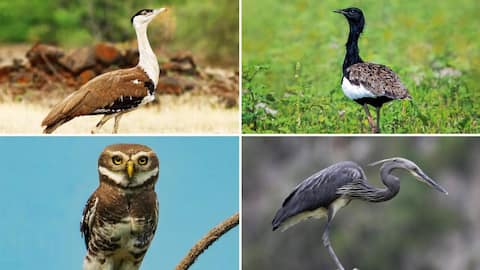Exploring vulnerable and endangered birds in India
What's the story
India, with its rich biodiversity, is a sanctuary for countless species of birds. However, alongside this natural wealth comes the looming threat of habitat loss, climate change, pollution, and illegal poaching. Among the avian population, several species are classified as vulnerable and endangered, according to the International Union for Conservation of Nature (IUCN). These birds face significant challenges that put their survival at risk.
Shrinking habita
The Great Indian Bustard
Once considered a contender for the prestigious title of India's national bird, the Great Indian Bustard (GIB) is now battling for survival. The bird is now critically endangered, with less than 150 remaining in fragmented populations across Rajasthan, Gujarat, Maharashtra, Karnataka and Andhra Pradesh. Major threats include habitat loss due to agricultural expansion and development projects, coupled with hunting and collision with power lines.
Diclofenac
Indian vulture
Once one of the most abundant scavengers in the Indian landscape, vulture populations have plummeted in recent decades due to the widespread use of the veterinary drug diclofenac. The drug, when consumed by vultures feeding on livestock treated with it, causes severe health consequences. Conservation efforts, such as captive breeding programs and banning diclofenac, aim to stop the decline. However, this recovery remains slow.
Habitat loss
Forest Owlett
Endemic to central India, Forest Owlett is found only in the Narmada valley. The bird was considered extinct for over a century until its rediscovery in 1997. However, it remains critically endangered due to habitat loss and degradation caused by deforestation and agricultural expansion. Limited knowledge about its ecology and habitat requirements further complicates conservation efforts.
Dwindling fish
White Bellied Heron
Residing in the forests of India, Bhutan, and Myanmar, the bird thrives in the Himalayan foothills, relying on expansive, fast-flowing rivers for sustenance. With remarkable agility, it adeptly captures fish in swift currents, a behavior unique to heron species. However, human encroachment, dwindling fish stocks, and sand mining pose significant threats, causing distress and precipitating a decline in their population.
Rapid urbanization
Bengal Florican
The species once thrived in the grasslands of northern and northeastern India, particularly in states like Assam, Uttar Pradesh, Bihar, and West Bengal. However, rapid urbanization, agricultural intensification, and industrialization have drastically reduced suitable habitats for the Bengal Florican. Today, fragmented populations are found in isolated patches of grasslands of Kaziranga National Park in Assam and Manas National Park in Assam and Bhutan.
